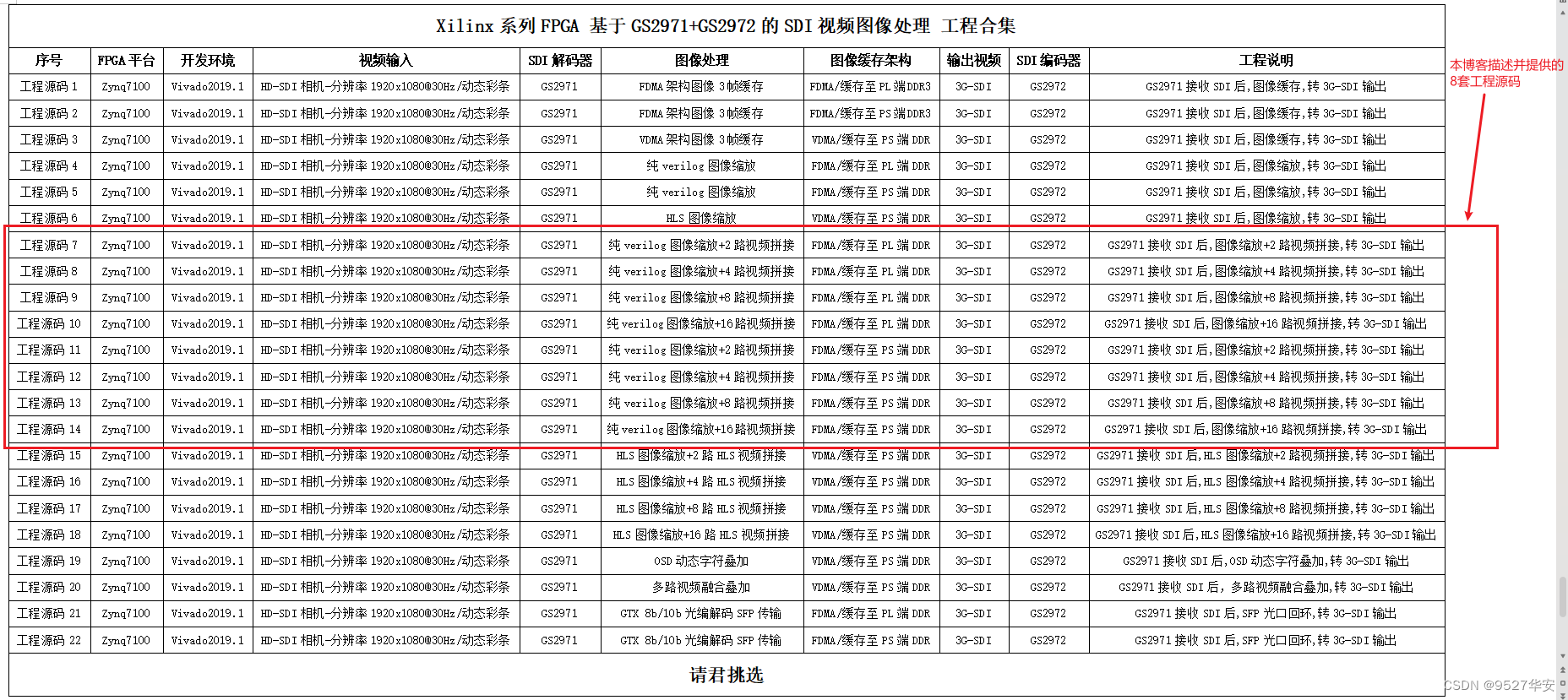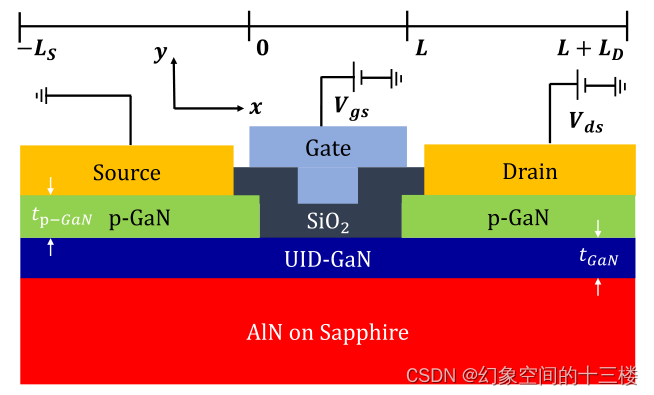个人主页:Lei宝啊
愿所有美好如期而遇
前言
前面我们对红黑树进行了模拟实现:
现在我们将使用我们模拟的map和set对我们模拟的红黑树进行封装。
并且,本篇将增加红黑树的迭代器,模拟迭代器++(这里理解原理即可,--反过来就可以,唯一不同在于end()位置--,我们单独判断即可),然后建立我们自己的map和set对红黑树进行封装,同时为map重载operator[],添加map和set迭代器,insert方法。
红黑树代码
#pragma once
#include <iostream>
using namespace std;
enum Color
{
RED,
BLACK
};
template<class K, class T>
struct RBTreeNode
{
struct RBTreeNode* _left;
struct RBTreeNode* _right;
struct RBTreeNode* _parent;
pair<K, T> _p;
int _color;
RBTreeNode(const K& key, const T& val)
: _left(nullptr)
, _right(nullptr)
, _parent(nullptr)
, _color(RED)
, _p(key, val)
{}
};
template<class K, class T>
class RBTree
{
typedef RBTreeNode<K, T> Node;
public:
bool Insert(const K& key, const T& val)
{
Node* newnode = new Node(key, val);
if (_root == nullptr)
{
_root = newnode;
_root->_color = BLACK;
return true;
}
Node* cur = _root;
Node* par = nullptr;
while (cur)
{
par = cur;
if (cur->_p.first == key) return false;
else if (cur->_p.first < key) cur = cur->_right;
else cur = cur->_left;
}
if (par->_p.first > key) par->_left = newnode;
else par->_right = newnode;
newnode->_parent = par;
cur = newnode;
while (par && par->_color == RED)
{
Node* grandfather = par->_parent;
if (grandfather->_left == par)
{
Node* uncle = grandfather->_right;
//情况一:鼠鼠存在且为红色
if (uncle && uncle->_color == RED)
{
par->_color = BLACK;
uncle->_color = BLACK;
grandfather->_color = RED;
cur = grandfather;
par = cur->_parent;
}
//情况二:鼠鼠不存在或者鼠鼠为黑色(可以一同处理)
else
{
//左左,右单旋
if (cur == par->_left)
{
RotateR(grandfather);
grandfather->_color = RED;
par->_color = BLACK;
}
//左右,左右双旋
else
{
RotateL(par);
RotateR(grandfather);
cur->_color = BLACK;
grandfather->_color = RED;
}
break;
}
}
else
{
Node* uncle = grandfather->_left;
//情况一:鼠鼠存在且为红色
if (uncle && uncle->_color == RED)
{
par->_color = BLACK;
uncle->_color = BLACK;
grandfather->_color = RED;
cur = grandfather;
par = cur->_parent;
}
//情况二:鼠鼠不存在或者鼠鼠为黑色(可以一同处理)
else
{
//右右,左单旋
if (cur == par->_right)
{
RotateL(grandfather);
grandfather->_color = RED;
par->_color = BLACK;
}
//右左,右左双旋
else
{
RotateR(par);
RotateL(grandfather);
cur->_color = BLACK;
grandfather->_color = RED;
}
break;
}
}
}
_root->_color = BLACK;
return true;
}
bool IsBlance()
{
if (_root && _root->_color == RED)
return false;
int standard_black_num = 0;
Node* cur = _root;
while (cur)
{
if (cur->_color == BLACK)
standard_black_num++;
cur = cur->_left;
}
return _IsBlance(_root, 0, standard_black_num);
}
void Inorder()
{
return _Inorder(_root);
}
private:
// 检查这棵树是否是红黑树
// 1、遵守根节点为黑色
// 2、遵守不能有连续的红色节点
// 3、每条路径黑色节点数量相同
//
// 遵守最长路径不超过最短路径的两倍,最长路径为一黑一红,最短路径为全黑。
bool _IsBlance(Node *root, int real_black_num, int standard_black_num)
{
if (root == nullptr)
{
if (real_black_num != standard_black_num)
return false;
return true;
}
if (root != _root && root->_color == RED && root->_parent->_color == RED)
return false;
if (root->_color == BLACK)
real_black_num++;
return _IsBlance(root->_left, real_black_num, standard_black_num)
&& _IsBlance(root->_right, real_black_num, standard_black_num);
}
void _Inorder(Node* root)
{
if (root == nullptr)
return;
_Inorder(root->_left);
cout << root->_p.first << " : " << root->_p.second << endl;
_Inorder(root->_right);
}
//左单旋
void RotateL(Node* par)
{
Node* subR = par->_right;
Node* subRL = subR->_left;
par->_right = subRL;
if (subRL)
subRL->_parent = par;
Node* p_par = par->_parent;
subR->_left = par;
par->_parent = subR;
if (p_par == nullptr)
{
_root = subR;
subR->_parent = nullptr;
}
else
{
if (p_par->_left == par)
{
p_par->_left = subR;
subR->_parent = p_par;
}
else
{
p_par->_right = subR;
subR->_parent = p_par;
}
}
}
//右单旋
void RotateR(Node* par)
{
Node* subL = par->_left;
Node* subLR = subL->_right;
par->_left = subLR;
if (subLR)
subLR->_parent = par;
Node* p_par = par->_parent;
subL->_right = par;
par->_parent = subL;
if (p_par == nullptr)
{
_root = subL;
subL->_parent = nullptr;
}
else
{
if (p_par->_left == par)
{
p_par->_left = subL;
subL->_parent = p_par;
}
else
{
p_par->_right = subL;
subL->_parent = p_par;
}
}
}
Node* _root = nullptr;
};map类结构
这是我们最终的结果,可以先大致看一下,我们后面会对每一个细节和结构进行讲解。
#pragma once
#include "Map_Set_use_RBTree.h"
template<class K, class T>
class my_map
{
struct MapKeyOf
typedef typename
RBTree<K, pair<const K, T>, MapKeyOf>::iterator iterator;
typedef typename
RBTree<K, pair<const K, const T>, MapKeyOf>::const_iterator const_iterator;
public:
T& operator[](const K& key)
iterator begin()
iterator end()
const_iterator begin()const
const_iterator end()const
pair<iterator, bool> insert(const pair<const K, T>& data)
private:
RBTree<K, pair<const K, T>, MapKeyOf> _t;
};
set类结构
这是我们最终的结果,可以先大致看一下,我们后面会对每一个细节和结构进行讲解。
#pragma once
#include "Map_Set_use_RBTree.h"
template<class T>
class my_set
{
//仿函数,提取key值,底层的红黑树进行比较
struct SetKeyOf
typedef typename
RBTree<T, const T, SetKeyOf>::iterator iterator;
typedef typename
RBTree<T, const T, SetKeyOf>::const_iterator const_iterator;
public:
bool Insert(const T& data)
iterator begin()
iterator end()
const_iterator begin()const
const_iterator end()const
pair<iterator, bool> insert(const T& data)
private:
RBTree<T, const T, SetKeyOf> _t;
};
红黑树迭代器
从这里开始,我们将详细说明map、set的封装细节以及迭代器的实现和封装。
首先是红黑树的迭代器,我们的迭代器首先应该是指向红黑树节点的,之后我们的迭代器++和--按照中序遍历的顺序迭代,而我们红黑树的节点直接++是无法到达下一个节点的,同时我们在创建红黑树对象后,使用红黑树的begin()和end()获得迭代器,返回值是迭代器对象,而这个迭代器是指向红黑树节点的,我们不可能获得一个函数类型的返回值,所以我们不在红黑树的类里去实现红黑树的迭代器。
我们写一个迭代器类:RBTreeIterator,这个类的大致结构是这样的:
template <class T, class Ptr, class Ref>
struct RBTreeIterator
{
typedef RBTreeNode<T> Node;
RBTreeIterator(Node* node)
: _node(node)
{}
Ptr operator->();
Ref operator *();
bool operator==(const RBTreeIterator& s);
bool operator!=(const RBTreeIterator& s);
RBTreeIterator& operator++();
RBTreeIterator& operator--();
Node* _node;
};_node是我们通过红黑树类的方法构建这个类的对象而进行初始化的,而这个节点++或--就是我们要实现的。
我们先来实现operator++的运算符重载,返回类型当然还是我们这个类的对象,现在我们给出一个图,思考如何按照中序找到一个节点的下一个节点。
 我们现在想要找出cur节点的下一个节点,也就是node6节点,如何得到node6节点呢?
我们现在想要找出cur节点的下一个节点,也就是node6节点,如何得到node6节点呢?
如果我们想要node2的下一个节点,也就是node1节点,又如何得到node1节点呢?
首先我们先来看node2节点,他的右节点是空的,所以直接返回到上一个节点,也就到了node1节点,而如果是node3节点,他的右节点不为空,就到了node5节点,而node5节点的左是空的,那么我们也就得到了node3节点。
也就是说,如果当前节点的右为空,那么就会返回去找未走过的祖先(这里我们指出,就是孩子节点为父节点左孩子的祖先节点),如果右不为空,那么就会走右子树的最左节点。
所以node6节点是cur节点右树的最左节点,也就是我们要的节点。
所以我们这样实现这个operator++:
RBTreeIterator& operator++()
{
if (_node->_right)
{
Node* subRL = _node->_right;
while (subRL->_left)
{
subRL = subRL->_left;
}
_node = subRL;
}
else
{
Node* cur = _node;
Node* parent = cur->_parent;
while (parent && parent->_left != cur)
{
cur = parent;
parent = parent->_parent;
}
_node = parent;
}
return *this;
} operator--就是逻辑反一下,并且加上一个特殊判断,当节点位于end()位置,也就是空位置时,我们对节点--应该是到最大的那个节点,也就是右树的最右节点,我们单独作处理即可,这里不多做解释和实现。
现在,我们给出完整的迭代器类:
这里我们解释一下Ptr参数和Ref参数,Ptr参数我们将来可以传T*或者const T*,Ref参数将来可以传T&或者const T&。
template <class T, class Ptr, class Ref>
struct RBTreeIterator
{
typedef RBTreeNode<T> Node;
RBTreeIterator(Node* node)
: _node(node)
{}
Ptr operator->()
{
return &_node->_data;
}
Ref operator *()
{
return _node->_data;
}
bool operator==(const RBTreeIterator& s)
{
return _node == s._node;
}
bool operator!=(const RBTreeIterator& s)
{
return _node != s._node;
}
//前置++
//寻找节点的右子树不为空的最左节点,否则寻找孩子为父亲左孩子的祖先节点
RBTreeIterator& operator++()
{
if (_node->_right)
{
Node* subRL = _node->_right;
while (subRL->_left)
{
subRL = subRL->_left;
}
_node = subRL;
}
else
{
Node* cur = _node;
Node* parent = cur->_parent;
while (parent && parent->_left != cur)
{
cur = parent;
parent = parent->_parent;
}
_node = parent;
}
return *this;
}
Node* _node;
};
现在我们来为红黑树类添加迭代器:
以下代码新增于红黑树类内,
typedef RBTreeIterator<T, T*, T&> iterator;
typedef RBTreeIterator<T, const T*, const T&> const_iterator;
iterator begin()
{
Node* cur = _root;
while (cur && cur->_left)
{
cur = cur->_left;
}
return iterator(cur);
}
iterator end()
{
return iterator(nullptr);
}
const_iterator begin() const
{
Node* cur = _root;
while (cur && cur->_left)
{
cur = cur->_left;
}
return const_iterator(cur);
}
const_iterator end() const
{
return const_iterator(nullptr);
}此时如果我们定义一个红黑树对象a,并定义RBTree<省略>::iterator it = a.begin(); a.begin()返回一个RBTreeIterator类型的迭代器对象,当我们it++时,调用的就是it这个对象的operator++。
map、set迭代器
接下来我们要为map和set的迭代器做准备,首先先对红黑树进行一些改变,首先是参数:
template<class K, class T, class KeyOf>我们多了一个参数,KeyOf,这个参数我们将来当做仿函数使用,是为了insert方法做出的改变,我们希望这个仿函数能够提取出节点的key值,方便我们map节点pair<>中的key进行比较。
这里我们的T参数,将来传值可能是set的key,或者是map的pair<>,而K这个参数将在find和erase方法中用到,insert方法的返回值我们参照库里修改为pair<itreator,bool>,这里面的Iterator指的是指向红黑树节点的迭代器,bool是指是否插入成功。
首先我们来看修改后的insert方法:
pair<iterator, bool> Insert(const T& data)
{
KeyOf compare;
Node* newnode = new Node(data);
if (_root == nullptr)
{
_root = newnode;
_root->_color = BLACK;
return make_pair(iterator(newnode), true);
}
Node* cur = _root;
Node* par = nullptr;
while (cur)
{
par = cur;
if (compare(data) < compare(cur->_data)) cur = cur->_left;
else if (compare(cur->_data) < compare(data)) cur = cur->_right;
else return make_pair(iterator(cur), false);
}
if (compare(data) < compare(par->_data)) par->_left = newnode;
else par->_right = newnode;
newnode->_parent = par;
cur = newnode;
Node* renode = newnode;
while (par && par->_color == RED)
{
Node* grandfather = par->_parent;
if (grandfather->_left == par)
{
Node* uncle = grandfather->_right;
//情况一:鼠鼠存在且为红色
if (uncle && uncle->_color == RED)
{
par->_color = BLACK;
uncle->_color = BLACK;
grandfather->_color = RED;
cur = grandfather;
par = cur->_parent;
}
//情况二:鼠鼠不存在或者鼠鼠为黑色(可以一同处理)
else
{
//左左,右单旋
if (cur == par->_left)
{
RotateR(grandfather);
grandfather->_color = RED;
par->_color = BLACK;
}
//左右,左右双旋
else
{
RotateL(par);
RotateR(grandfather);
cur->_color = BLACK;
grandfather->_color = RED;
}
break;
}
}
else
{
Node* uncle = grandfather->_left;
//情况一:鼠鼠存在且为红色
if (uncle && uncle->_color == RED)
{
par->_color = BLACK;
uncle->_color = BLACK;
grandfather->_color = RED;
cur = grandfather;
par = cur->_parent;
}
//情况二:鼠鼠不存在或者鼠鼠为黑色(可以一同处理)
else
{
//右右,左单旋
if (cur == par->_right)
{
RotateL(grandfather);
grandfather->_color = RED;
par->_color = BLACK;
}
//右左,右左双旋
else
{
RotateR(par);
RotateL(grandfather);
cur->_color = BLACK;
grandfather->_color = RED;
}
break;
}
}
}
_root->_color = BLACK;
return make_pair(iterator(renode), true);
}接下来就是map和set的迭代器:
map:
这里我们对迭代器进行解释,RBTree<K, pair<const K, T>, MapKeyOf>::iterator 这里的一堆参数是传给RBTree类的,我们这里的Iterator本质是RBTree的Iterator,而RBTree的Iterator本质是RBTreeIterator的,也就是说,实际上,我们在创建好一个map对象后,当我们调用迭代器时,实际是这样的:
map<string, int> m;
map<string,int>::iterator it = m.begin(); 这个begin()的返回值是RBTree<>::iterator,也就是RBTreeIterator的对象,我们将来it++,实际上就是这个对象调用他类里的operator++。
而我们底层用的当然是红黑树,所以也就创建红黑树对象,当我们想要插入值等等操作,直接调用红黑树里的方法即可,事实上,我们这个类除了仿函数,仅仅只是对红黑树的方法做了一层封装。
set也是同样的道理。
template<class K, class T>
class my_map
{
struct MapKeyOf
{
const K& operator()(const pair<const K, T>& data)
{
return data.first;
}
};
typedef typename
RBTree<K, pair<const K, T>, MapKeyOf>::iterator iterator;
typedef typename
RBTree<K, pair<const K, const T>, MapKeyOf>::const_iterator const_iterator;
public:
iterator begin()
{
return _t.begin();
}
iterator end()
{
return _t.end();
}
const_iterator begin()const
{
return _t.begin();
}
const_iterator end()const
{
return _t.end();
}
pair<iterator, bool> insert(const pair<const K, T>& data)
{
return _t.Insert(data);
}
private:
RBTree<K, pair<const K, T>, MapKeyOf> _t;
};set:
template<class T>
class my_set
{
//仿函数,提取key值,底层的红黑树进行比较
struct SetKeyOf
{
const T& operator()(const T& key)
{
return key;
}
};
typedef typename
RBTree<T, const T, SetKeyOf>::iterator iterator;
typedef typename
RBTree<T, const T, SetKeyOf>::const_iterator const_iterator;
public:
bool Insert(const T& data)
{
return _t.Insert(data);
}
iterator begin()
{
return _t.begin();
}
iterator end()
{
return _t.end();
}
const_iterator begin()const
{
return _t.begin();
}
const_iterator end()const
{
return _t.end();
}
pair<iterator, bool> insert(const T& data)
{
return _t.Insert(data);
}
private:
RBTree<T, const T, SetKeyOf> _t;
};
map的operator[]重载
T& operator[](const K& key)
{
//iterator是map中pair的地址
pair<iterator, bool> it = insert(make_pair(key, T()));
return it.first->second;
}我们使用map时也就是做插入、查找以及修改value这么些操作,那么它的返回值理所当然是T&,这里的T和RBTRee的T是不一样的,这里的T类型是value的类型,而RETree的T是pair<K,T>类型的。
我们知道insert返回值是pair<iterator,bool>,这里的Iterator就是RBTreeIterator的对象,bool就是是否插入成功,我们返回值是这样的,it.first是取到这个迭代器,这个迭代器是指向一个RBTreeIterator的对象,并且这个对象的类里重载了->()方法,假设这个对象叫做a,我们这样使用:a.operator->()就是取到了pair<>节点的地址,再这样: a.operator->()->second,也就取出了T&的值,但是这样写比较长,我们正常情况应该是这样:a->->second,但是编译器省略了一个,也就是这样:a->second,多写反而是错的。
整体代码
#pragma once
#include "Map_Set_use_RBTree.h"
template<class T>
class my_set
{
//仿函数,提取key值,底层的红黑树进行比较
struct SetKeyOf
{
const T& operator()(const T& key)
{
return key;
}
};
typedef typename RBTree<T, const T, SetKeyOf>::iterator iterator;
typedef typename RBTree<T, const T, SetKeyOf>::const_iterator const_iterator;
public:
bool Insert(const T& data)
{
return _t.Insert(data);
}
iterator begin()
{
return _t.begin();
}
iterator end()
{
return _t.end();
}
const_iterator begin()const
{
return _t.begin();
}
const_iterator end()const
{
return _t.end();
}
pair<iterator, bool> insert(const T& data)
{
return _t.Insert(data);
}
private:
RBTree<T, const T, SetKeyOf> _t;
};
#pragma once
#include "Map_Set_use_RBTree.h"
template<class K, class T>
class my_map
{
struct MapKeyOf
{
const K& operator()(const pair<const K, T>& data)
{
return data.first;
}
};
typedef typename RBTree<K, pair<const K, T>, MapKeyOf>::iterator iterator;
typedef typename RBTree<K, pair<const K, const T>, MapKeyOf>::const_iterator const_iterator;
public:
T& operator[](const K& key)
{
//iterator是map中pair的地址
pair<iterator, bool> it = insert(make_pair(key, T()));
return it.first->second;
}
iterator begin()
{
return _t.begin();
}
iterator end()
{
return _t.end();
}
const_iterator begin()const
{
return _t.begin();
}
const_iterator end()const
{
return _t.end();
}
pair<iterator, bool> insert(const pair<const K, T>& data)
{
return _t.Insert(data);
}
private:
RBTree<K, pair<const K, T>, MapKeyOf> _t;
};
#pragma once
#pragma once
#include <iostream>
using namespace std;
enum Color
{
RED,
BLACK
};
//树的节点,作为RBTree的成员变量。
template<class T>
struct RBTreeNode
{
struct RBTreeNode* _left;
struct RBTreeNode* _right;
struct RBTreeNode* _parent;
T _data;
Color _color;
RBTreeNode(const T& data)
: _left(nullptr)
, _right(nullptr)
, _parent(nullptr)
, _color(RED)
, _data(data)
{}
};
//作为RBTree的迭代器,在RBTree内使用,接收来自RBTree内的Node节点
template <class T, class Ptr, class Ref>
struct RBTreeIterator
{
typedef RBTreeNode<T> Node;
RBTreeIterator(Node* node)
: _node(node)
{}
Ptr operator->()
{
return &_node->_data;
}
Ref operator *()
{
return _node->_data;
}
bool operator==(const RBTreeIterator& s)
{
return _node == s._node;
}
bool operator!=(const RBTreeIterator& s)
{
return _node != s._node;
}
//前置++
//寻找节点的右子树不为空的最左节点,否则寻找孩子为父亲左孩子的祖先节点
RBTreeIterator& operator++()
{
if (_node->_right)
{
Node* subRL = _node->_right;
while (subRL->_left)
{
subRL = subRL->_left;
}
_node = subRL;
}
else
{
Node* cur = _node;
Node* parent = cur->_parent;
while (parent && parent->_left != cur)
{
cur = parent;
parent = parent->_parent;
}
_node = parent;
}
return *this;
}
/**
* @param null
* 前置--
* 寻找孩子的左子树不为空的最右节点,否则寻找孩子为父亲右孩子的祖先节点
*/
RBTreeIterator& operator--()
{
if (_node->_left)
{
Node* cur = _node->_left;
while (cur->_right)
{
cur = cur->_right;
}
_node = cur;
}
else
{
Node* cur = _node;
Node* parent = cur->_parent;
while (parent && cur != parent->_right)
{
cur = parent;
parent = parent->_parent;
}
_node = cur;
}
return *this;
}
Node* _node;
};
//红黑树的实现
template<class K, class T, class KeyOf>
class RBTree
{
public:
typedef RBTreeNode<T> Node;
typedef RBTreeIterator<T, T*, T&> iterator;
typedef RBTreeIterator<T, const T*, const T&> const_iterator;
iterator begin()
{
Node* cur = _root;
while (cur && cur->_left)
{
cur = cur->_left;
}
return iterator(cur);
}
iterator end()
{
return iterator(nullptr);
}
const_iterator begin() const
{
Node* cur = _root;
while (cur && cur->_left)
{
cur = cur->_left;
}
return const_iterator(cur);
}
const_iterator end() const
{
return const_iterator(nullptr);
}
pair<iterator, bool> Insert(const T& data)
{
KeyOf compare;
Node* newnode = new Node(data);
if (_root == nullptr)
{
_root = newnode;
_root->_color = BLACK;
return make_pair(iterator(newnode), true);
}
Node* cur = _root;
Node* par = nullptr;
while (cur)
{
par = cur;
if (compare(data) < compare(cur->_data)) cur = cur->_left;
else if (compare(cur->_data) < compare(data)) cur = cur->_right;
else return make_pair(iterator(cur), false);
}
if (compare(data) < compare(par->_data)) par->_left = newnode;
else par->_right = newnode;
newnode->_parent = par;
cur = newnode;
Node* renode = newnode;
while (par && par->_color == RED)
{
Node* grandfather = par->_parent;
if (grandfather->_left == par)
{
Node* uncle = grandfather->_right;
//情况一:鼠鼠存在且为红色
if (uncle && uncle->_color == RED)
{
par->_color = BLACK;
uncle->_color = BLACK;
grandfather->_color = RED;
cur = grandfather;
par = cur->_parent;
}
//情况二:鼠鼠不存在或者鼠鼠为黑色(可以一同处理)
else
{
//左左,右单旋
if (cur == par->_left)
{
RotateR(grandfather);
grandfather->_color = RED;
par->_color = BLACK;
}
//左右,左右双旋
else
{
RotateL(par);
RotateR(grandfather);
cur->_color = BLACK;
grandfather->_color = RED;
}
break;
}
}
else
{
Node* uncle = grandfather->_left;
//情况一:鼠鼠存在且为红色
if (uncle && uncle->_color == RED)
{
par->_color = BLACK;
uncle->_color = BLACK;
grandfather->_color = RED;
cur = grandfather;
par = cur->_parent;
}
//情况二:鼠鼠不存在或者鼠鼠为黑色(可以一同处理)
else
{
//右右,左单旋
if (cur == par->_right)
{
RotateL(grandfather);
grandfather->_color = RED;
par->_color = BLACK;
}
//右左,右左双旋
else
{
RotateR(par);
RotateL(grandfather);
cur->_color = BLACK;
grandfather->_color = RED;
}
break;
}
}
}
_root->_color = BLACK;
return make_pair(iterator(renode), true);
}
bool IsBlance()
{
if (_root && _root->_color == RED)
return false;
int standard_black_num = 0;
Node* cur = _root;
while (cur)
{
if (cur->_color == BLACK)
standard_black_num++;
cur = cur->_left;
}
return _IsBlance(_root, 0, standard_black_num);
}
void Inorder()
{
return _Inorder(_root);
}
private:
// 检查这棵树是否是红黑树
// 1、遵守根节点为黑色
// 2、遵守不能有连续的红色节点
// 3、每条路径黑色节点数量相同
//
// 遵守最长路径不超过最短路径的两倍,最长路径为一黑一红,最短路径为全黑。
bool _IsBlance(Node* root, int real_black_num, int standard_black_num)
{
if (root == nullptr)
{
if (real_black_num != standard_black_num)
return false;
return true;
}
if (root != _root && root->_color == RED && root->_parent->_color == RED)
return false;
if (root->_color == BLACK)
real_black_num++;
return _IsBlance(root->_left, real_black_num, standard_black_num)
&& _IsBlance(root->_right, real_black_num, standard_black_num);
}
void _Inorder(Node* root)
{
if (root == nullptr)
return;
_Inorder(root->_left);
cout << root->_p.first << " : " << root->_p.second << endl;
_Inorder(root->_right);
}
//左单旋
void RotateL(Node* par)
{
Node* subR = par->_right;
Node* subRL = subR->_left;
par->_right = subRL;
if (subRL)
subRL->_parent = par;
Node* p_par = par->_parent;
subR->_left = par;
par->_parent = subR;
if (p_par == nullptr)
{
_root = subR;
subR->_parent = nullptr;
}
else
{
if (p_par->_left == par)
{
p_par->_left = subR;
subR->_parent = p_par;
}
else
{
p_par->_right = subR;
subR->_parent = p_par;
}
}
}
//右单旋
void RotateR(Node* par)
{
Node* subL = par->_left;
Node* subLR = subL->_right;
par->_left = subLR;
if (subLR)
subLR->_parent = par;
Node* p_par = par->_parent;
subL->_right = par;
par->_parent = subL;
if (p_par == nullptr)
{
_root = subL;
subL->_parent = nullptr;
}
else
{
if (p_par->_left == par)
{
p_par->_left = subL;
subL->_parent = p_par;
}
else
{
p_par->_right = subL;
subL->_parent = p_par;
}
}
}
Node* _root = nullptr;
};需要注意的点和容易犯错的点

这里需要注意到的是迭代器是RBTree里的迭代器,因为红黑树需要我们提供一种提取key的方法,所以才有了第三个参数。
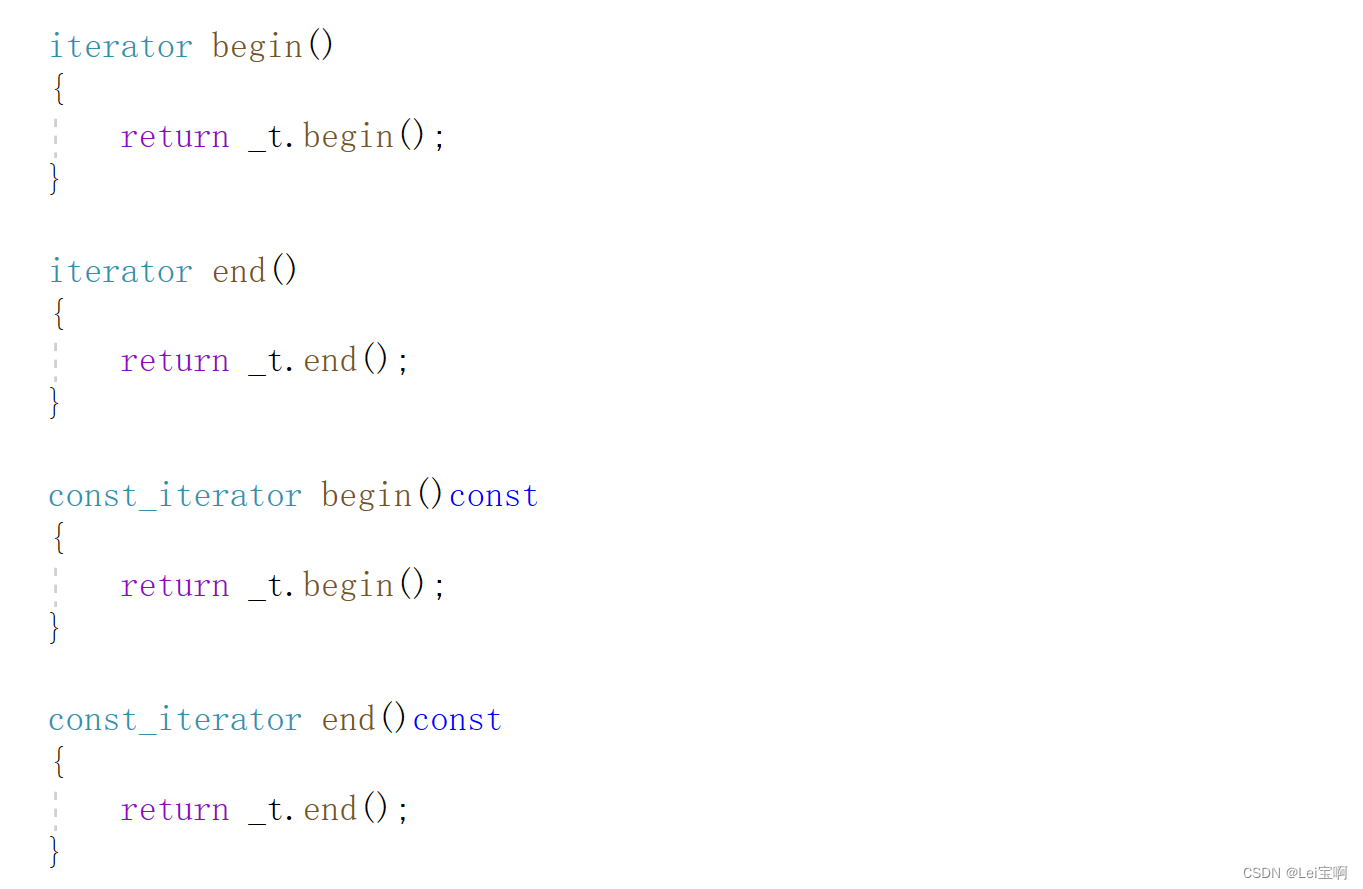
const迭代器并不是改了返回值就是const类型的方法了,需要this指针也是const类型。

明确自己的类里定义的成员变量,以及要传的参数。
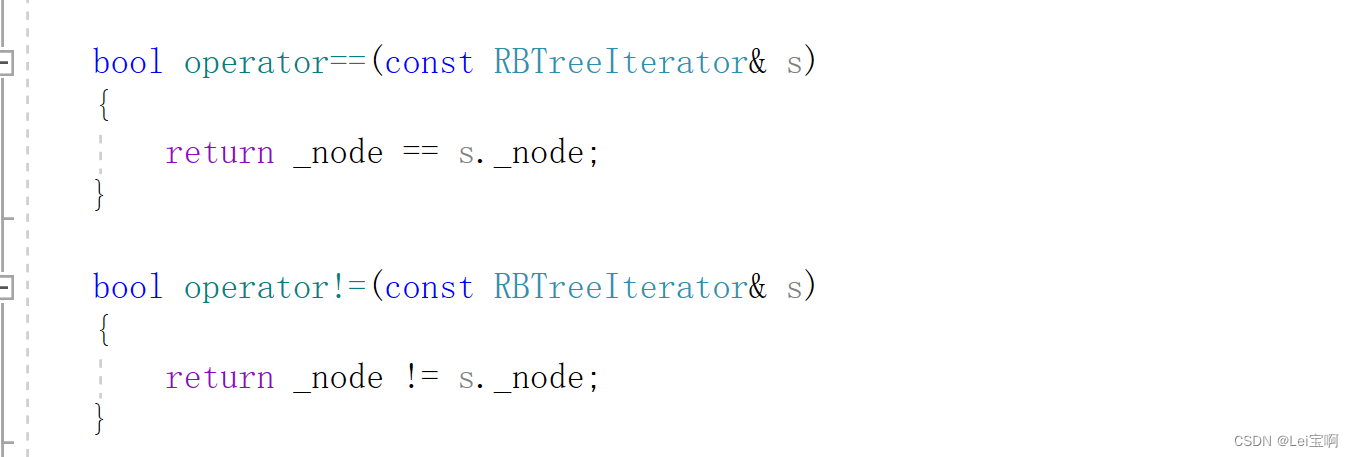 这里需要实现,范围for需要这个方法,同时,参数是本类的类型。
这里需要实现,范围for需要这个方法,同时,参数是本类的类型。

_node和_right写对,不要少了_。
 这些只是重命名,:: 前的是类的类型,后面才是迭代器,表示某个类里的迭代器,这么一层层下去,实际上用的一直都是RBTreeIterator的对象。
这些只是重命名,:: 前的是类的类型,后面才是迭代器,表示某个类里的迭代器,这么一层层下去,实际上用的一直都是RBTreeIterator的对象。



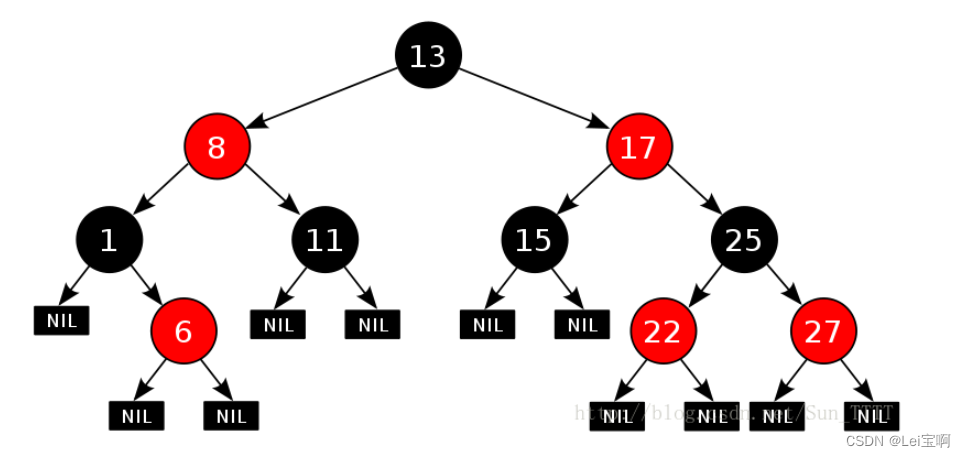
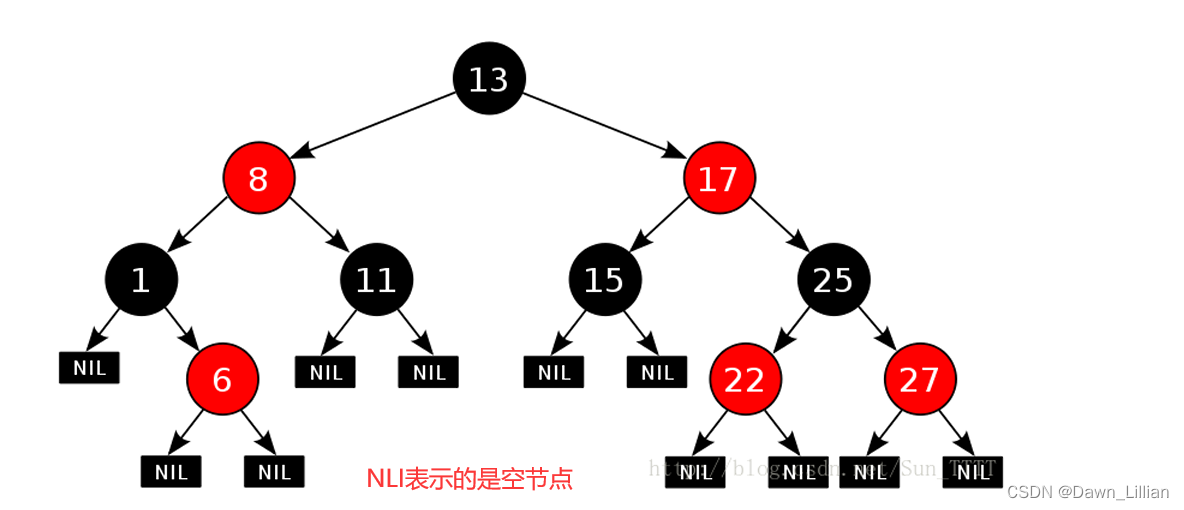
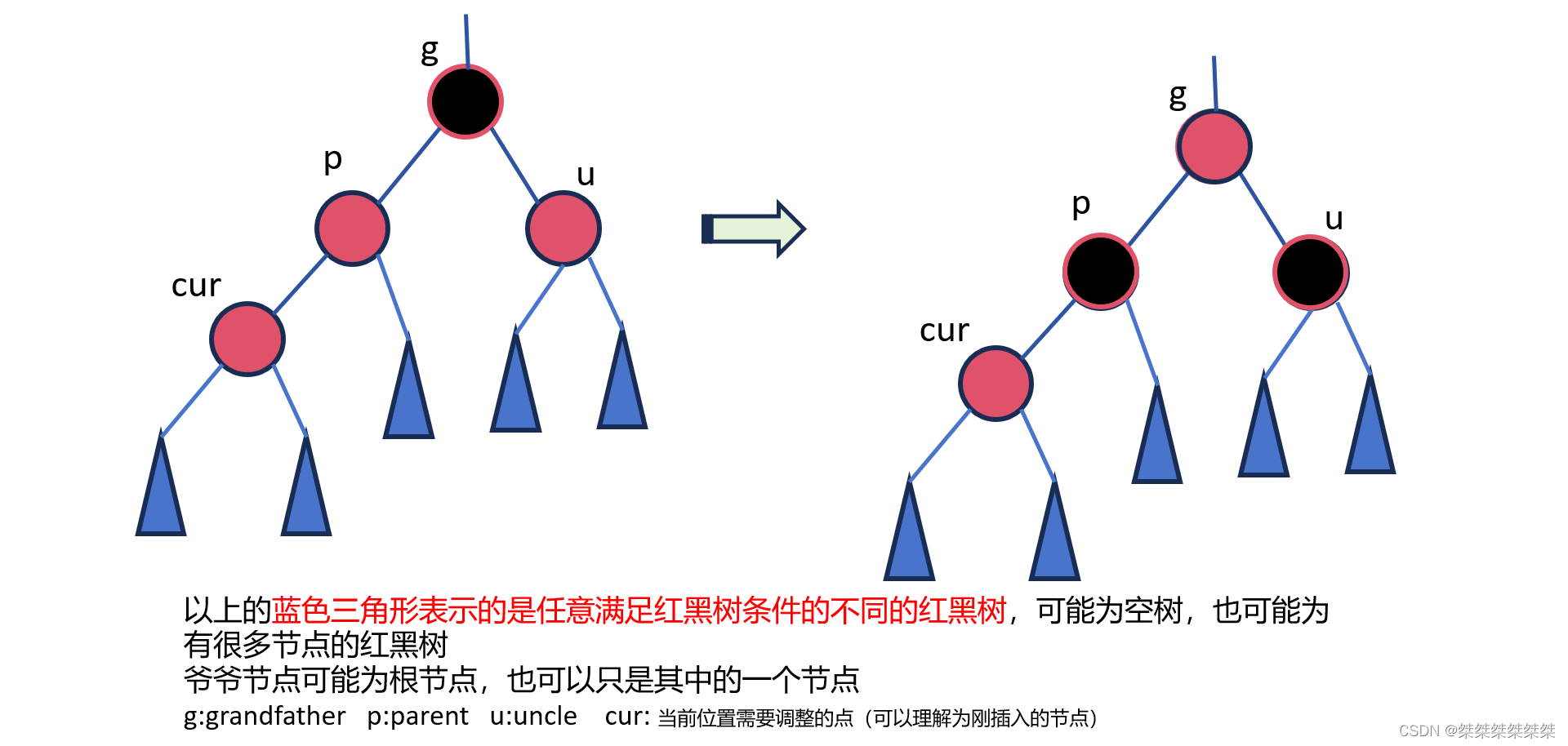

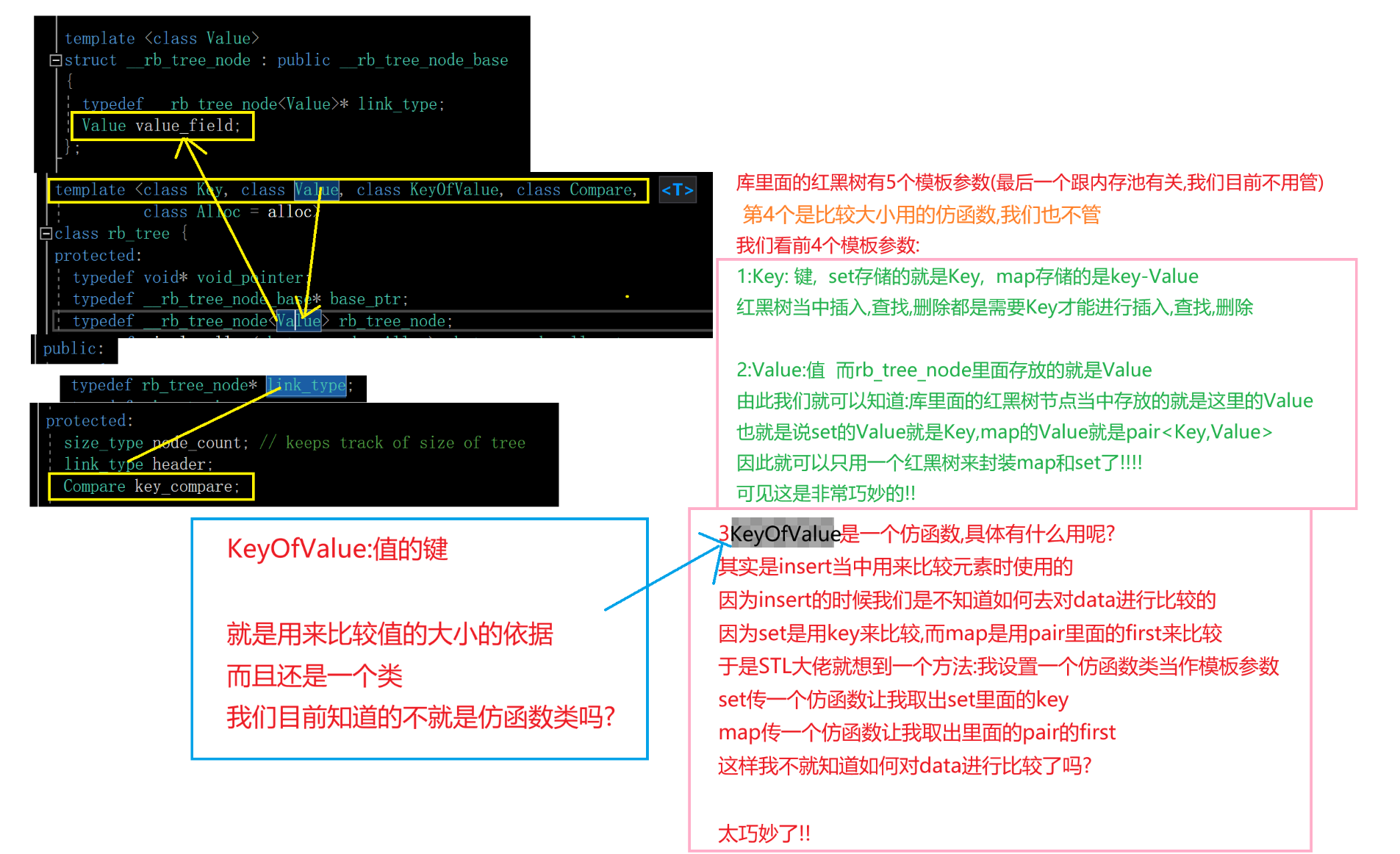





















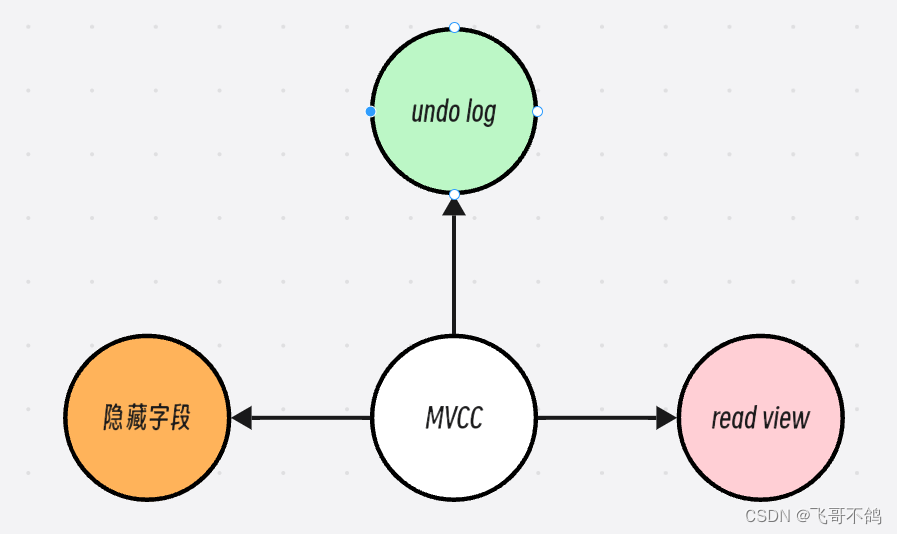


![sql server [使用游标] 将表数据打印成sql insert语句](https://img-blog.csdnimg.cn/direct/6289095a0b6343ea87bc24982387d0ec.png)
